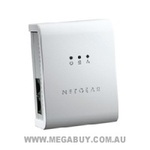While Stocks Last!
Single Unit — http://www.megabuy.com.au/netgear-xe104-85mbps-4-port-powerl… $11.95 shipping
Double Pack — http://www.megabuy.com.au/netgear-bundle-2x-netgear-xe104-85… $15.95 Shipping
Triple Pack — http://www.megabuy.com.au/netgear-bundle-3x-netgear-xe104-85… $15.95 shipping
Overview
The Netgear XE104 85Mbps Powerline 4-Port Ethernet Adapter lets you easily extend a network using just the existing electric lines of your home, eliminating the need to run unsightly Ethernet wires all over your house or apartment. With four ports, you can connect multiple devices to one adapter and at 85 Mbps, you'll have more than enough speed to download music, stream videos, and make internet telephone calls without any hiccups.
Powerline 4-Port Ethernet Adapter
Delivers up to 85 Mbps wired speed
Extends home networks by using existing electrical wires,
Turns any outlet into four new Ethernet network connections
Simple plug-and-play installation
Turns electrical sockets into home network/Internet points
Three easy-to-read icon LEDs for quick status information
Simply plug one XE104 into your router and a second XE104 into as many as 4 networked devices


Really cheap, but really slow. This is one quarter the theoretical max of N (300Mb/s). So if you intend to stream or file transfer over this, I'd invest in something in the 200MB/s range, because If you are buying this to replace slow wireless it isn't going to fix the issue.
Though as I said, for the correct audience/crowd this is a steal me thinks.